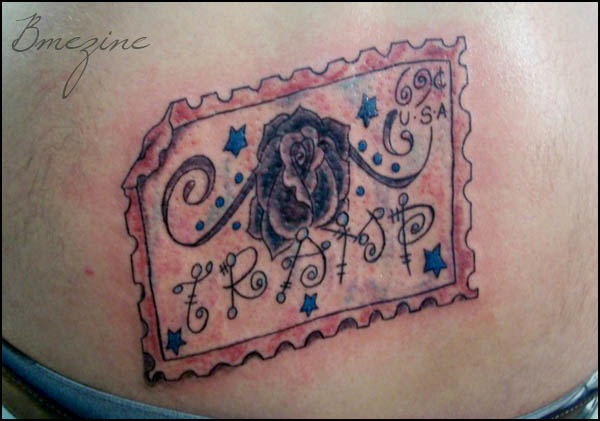
Stamped by Dani Demo, Dyeing Rites Tattoo, Elizabeth City, NC.

Stamped by Dani Demo, Dyeing Rites Tattoo, Elizabeth City, NC.
Does this photo of Rafa giving his girlfriend Mila some “lip service” remind you of anything?
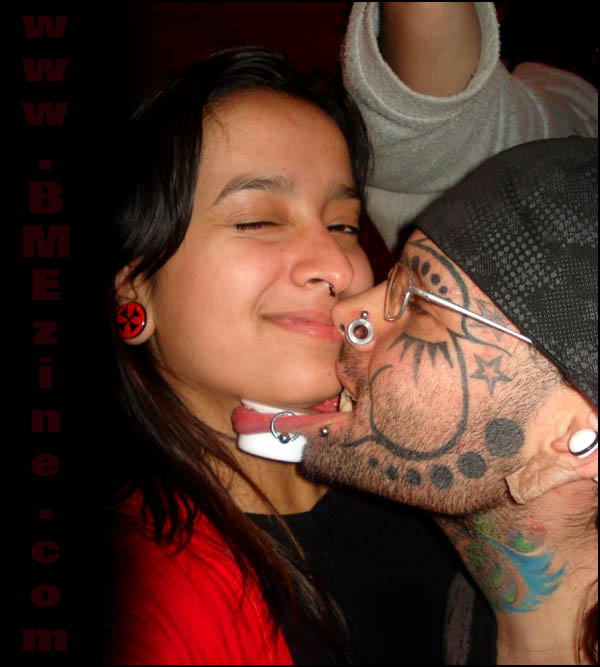
See more in “Scalpelled and other large gauge lip procedures“ (Lip Piercing)
If you’re black or white (or a mixture of both)..
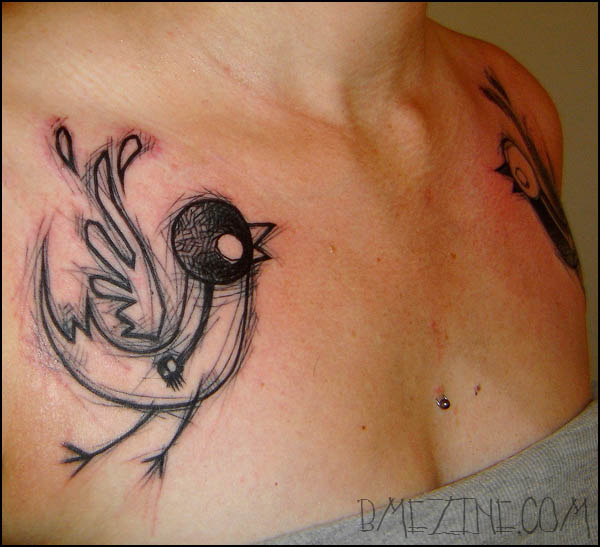
By Belly, Perpignan, France.
See more in “Wildlife and Nature Tattoos“ (Tattoos)

(Editor’s note: This article was first published in The Point, the publication of the Association of Professional Piercers. Since part of BME’s mandate is to create as comprehensive and well rounded an archive of body modification as possible, we feel these are important additions.
Paul King, the article’s author, has given BME permission to publish a series of articles he wrote for The Point that explore the anthropological history behind many modern piercings. This is another in that series.)
In the piercing world we have come to call the piercing of the ear’s concha a “conch” piercing, pronouncing the ch softly, as in “church.” However, per Webster’s New World Dictionary, 2nd edition, the correct pronunciation of the ch should be hard, sounding like the letter “K.” I bring this up merely as a matter of curiosity or trivial fact; I am certainly not suggesting the piercing community should stray from tradition. Sometime in the early 1990s, the original Nomad body piercing shop in San Francisco, owned by Blake Perlingieri and Kristian White, started referring to this piercing as the “Sadhu,” a rather catchy name that has stuck to an extent, and which refers collectively to Indian Hindu holy men. “Incorrectly they are sometimes referred to as ‘Fakirs’ who were originally Moslem street magicians who adopted a few yogic techniques for their repertoires and used them solely for entertainment.”1 It is a particular subsect of these Sadhus, the Gorak Naths or Gorakhnathis, that have their conchae pierced.
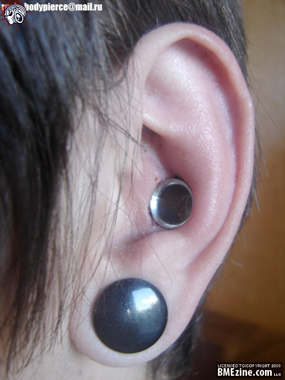 There is little historical documentation of the conch piercing, and its practice seems sporadic within different cultures. Other than the Gorak Naths, I have only found the Mangebetu to have strong cultural ties to the perforation and adorning of the Concha.
There is little historical documentation of the conch piercing, and its practice seems sporadic within different cultures. Other than the Gorak Naths, I have only found the Mangebetu to have strong cultural ties to the perforation and adorning of the Concha.
The Mangebetu, sometimes spelled Mangbetu, are an African tribe found in the Republic of Zaire (previously known as Congo). The Mangebetu were formerly regarded for their sophisticated court and developed arts; it is the women of this tribe that can still be seen wearing the beautiful long pieces of ivory in their conchae. The conch perforations often “hold monkey bones which are used to part their hair,”2 though sometimes, the bones were simply for decoration. In the past when elongation of the skull was more widely practiced, and hair styles were worn high to accentuate the skull’s shape, the conch jewelry was used to support the hair. The woman’s hair was sometimes extended using hair from the dead of an enemy tribe.
It’s impossible, of course, to say when the conch piercing was practiced for the first time. The history of the Sadhus has been long debated. Some archeologists believe that asceticism was implicit in the teachings of the Rg-Veda, written in the Vedic language, what we know as “The Vedas”, holy texts which came to India with the “invasion” of the Nordic Aryan Tribes around 1500 B.C.E. These Aryan tribes became the upper castes, the Brahmans, in the Hindu society. The other camp believes that yogic ascetic and other shamanistic practices can be traced much further back to the Indus Valley Culture, already fully developed in 2500 B.C.E. As is usually the case in history, it’s probably a little of both.
 “Almost nothing is known of the historical Gorakhnath. His personality was quickly distorted by myth and magical folklore … It seems he was an ascetic yogi who lived sometime around the ninth to 12th C.E. He established a new synthesis between Pasuhupata Shaivism, Tantra and the so-called Teachings of Siddhas. He was closely linked with Vajrayana (Tantric) Buddhism, and is also credited with the authorship of a lost treatise, called simply Hatha Yoga, and with the foundation of the movement of that same name. His teachings also involve the so-called “left-hand path” of Tantra, which involves sexual tantra with a partner, as opposed to simple visualization (the “right-hand” path).”3
“Almost nothing is known of the historical Gorakhnath. His personality was quickly distorted by myth and magical folklore … It seems he was an ascetic yogi who lived sometime around the ninth to 12th C.E. He established a new synthesis between Pasuhupata Shaivism, Tantra and the so-called Teachings of Siddhas. He was closely linked with Vajrayana (Tantric) Buddhism, and is also credited with the authorship of a lost treatise, called simply Hatha Yoga, and with the foundation of the movement of that same name. His teachings also involve the so-called “left-hand path” of Tantra, which involves sexual tantra with a partner, as opposed to simple visualization (the “right-hand” path).”3
“The main symbol that characterizes the Gorakhnathis, are huge earrings worn in split ears. Gorakhathis are also called Kanphatas or Kanphata Yogis (‘Kan’ meaning ear and ‘phat’ meaning split), because at the initiation ceremony the ears are split to insert enormous earrings. These earrings are commonly called yogi’s earrings and are made of agate, glass and various materials. Traditionally rhinoceros horn was a favorite because of its durability and because it is a sacred animal. Such rings covered with gold have been found. The wearing of the earrings is of great importance. If one is broken, another must be substituted before the yogi can eat, engage in conversation or carry out religious duties. Modern adherents claim this piercing the central hollow of the ears is a technique by which the acquisition of magical powers is promoted.”4
The piercing procedure is performed “with the double edge ‘Bhairavi knife’ (Bhairavi is a manifestation of Shiva). Before the operation, the Nath Babas are called Aughars — meaning ‘unfinished’ — and many will never reach the second stage.”5 It is not known at what point in the development of this subgroup of Sadhus, that they began piercing their conchae, if they originated the practice or if the practice existed in a previous sect. They have certainly been the only Hindu practitioners of this ritual for some time.

My usual disclaimer: I am not an anthropologist. From time to time, there will be errors. Please be understanding and forth coming if you have any information you would like to share.
Please consider buying a membership to BME so we can continue bringing you articles like this one.
![]()
I think Steve might have meant boogers (I prefer buggers, personally) but either way here he is wearing a new 5/8″ curved barbell in his Hobo piercing..
“For those who are interested but don’t know what they are, they go in like a Monroe but instead of going through into my mouth they curve upwards inside my lip and exit in my nose.
Not too sure what to call them! A couple of friends have dubbed them the Hobos (for obvious reasons). I’m glad they seem to be working out well, but I do know they are still very new and who knows what is to come with them. For now I’m very happy with them!“
By Sque3z, Anomaly Studios, Pasadena, CA.
See more in “Misc. Deep Piercing“ (Surface & Unusual Piercing)
Stigmata and Vigo..
Click through for a larger view of these photos (by Nolan Rudi), and be grateful I decided against calling this post Snakes and Lads.
“This video is a little fancier than the old 8mm conversions I’ve been sending in.
Filmed in South Florida in 1989 by Sailor Sid on a fancy VHS camcorder it features Jack Yount talking about his piercings and subincision. It’s living proof that the pre-1990s modification scene didn’t believe in wearing clothes. Which is how I like to remember Jack..
Cheers.
[Javascript required to view Flash movie, please turn it on and refresh this page]
A gorgeous pair of leg corsets by Kim of Steel Paintbrush, Durham, England.
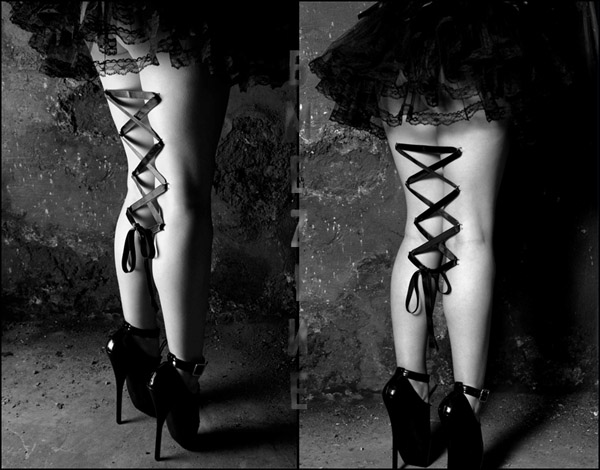
See more in “Body Surface Piercing: Body“ (Surface & Unusual Piercing)
ModBlog, meet Shawn (who solemnly swears that he is up to no good)..
Photo by Matt Lingo.